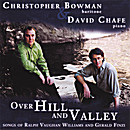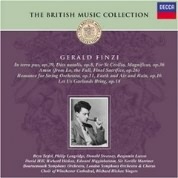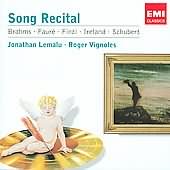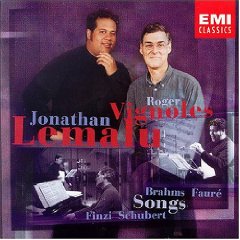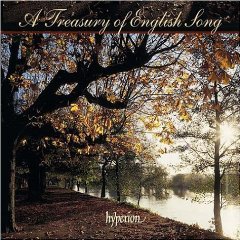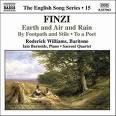The Clock of the Years
Poet: Thomas Hardy
Date of poem: 1916
Publication date: 1917
Publisher:
Collection: Moments of Vision
History of Poem:
Poem
The Clock of the Years |
||
|---|---|---|
'A spirit passed before my face; the hair of my flesh stood up.' |
||
| 1 | And the Spirit said, | |
| 2 | 'I can make the clock of the years go backward, | |
| 3 | But am loth to stop it where you will.' | |
| 4 | And I cried, 'Agreed | |
| 5 | To that. Proceed: | |
| 6 | It's better than dead!' | |
| 7 | He answered, 'Peace;' | |
| 8 | And called her up - as last before me; | |
| 9 | Then younger, younger she freshed, to the year | |
| 10 | I first had known | |
| 11 | Her woman-grown, | |
| 12 | And I cried, 'Cease! - | |
| 13 | 'Thus far is good - | |
| 14 | It is enough - let her stay thus always!' | |
| 15 | But alas for me - He shook his head: | |
| 16 | No stop was there; | |
| 17 | And she waned child-fair, | |
| 18 | And to babyhood. | |
| 19 | Still less in mien | |
| 20 | To my great sorrow became she slowly, | |
| 21 | And smalled till she was nought at all | |
| 22 | In his checkless griff; | |
| 23 | And it was as if | |
| 24 | She had never been. | |
| 25 | 'Better,' I plained, | |
| 26 | 'She were dead as before! The memory of her | |
| 27 | Had lived in me; but it cannot now!' | |
| 28 | And coldly his voice: | |
| 29 | 'It was your choice | |
| 30 | To mar the ordained.' | |
(Hardy, 528-9) |
||
Content/Meaning of the Poem:
Speaker:
Setting:
Purpose:
Idea or theme:
Style:
Form:
Synthesis:
Published comments about the poem:
✦✼✦✼✦✼✦✼✦✼✦✼✦✼✦✼✦✼✦✼✦✼✦✼✦✼✦✼✦✼✦✼✦✼✦
✦✼✦✼✦✼✦✼✦✼✦✼✦✼✦✼✦✼✦✼✦✼✦✼✦✼✦✼✦✼✦✼✦✼✦
Musical Analysis
Composition date:
Publication date:
Publisher: Boosey & Hawkes - Distributed by Hal Leonard Corporation
Tonality:
Transposition:
Duration:
Meter:
Tempo:
Form:
Rhythm:
Melody:
Texture:
Vocal Range:
Tessitura:
Dynamic Range:
Accompaniment:
Published comments about the music:
Pedagogical Considerations for Voice Students and Instructors:
✦✼✦✼✦✼✦✼✦✼✦✼✦✼✦✼✦✼✦✼✦✼✦✼✦✼✦✼✦✼✦✼✦✼✦
✦✼✦✼✦✼✦✼✦✼✦✼✦✼✦✼✦✼✦✼✦✼✦✼✦✼✦✼✦✼✦✼✦✼✦
| Pitch Analysis | ||||||
|---|---|---|---|---|---|---|
| pitch | stanza 1 |
stanza 2 |
stanza 3 |
stanza 4 |
total | |
highest |
A |
|||||
G |
||||||
F |
||||||
E |
||||||
D |
||||||
middle C |
||||||
B |
||||||
A |
||||||
G |
||||||
F |
||||||
lowest |
E |
|||||
| Rhythm Duration Analysis of Vocal Line | |||||
|---|---|---|---|---|---|
| stanza 1 | stanza 2 | stanza 3 | stanza 4 | total | |
16th note |
|||||
8th note |
|||||
dotted 8th |
|||||
quarter note |
|||||
dotted quarter |
|||||
triplet |
|||||
half note |
|||||
dotted half |
|||||
stanza total |
|||||
✦✼✦✼✦✼✦✼✦✼✦✼✦✼✦✼✦✼✦✼✦✼✦✼✦✼✦✼✦✼✦✼✦✼✦
Audio Recordings
Over Hill and Valley: Songs of Ralph Vaughan Williams and Gerald Finzi |
|
|
|
The British Music Collection: Gerald Finzi |
|
|
|
Song Recital |
|
|
|
Songs: Brahms - Faure - Finzi - Schubert |
|
|
|
The Songs of Gerald Finzi to Words by Thomas Hardy
|
|
|
|
A Treasury of English Song |
|
|
|
Gerald Finzi |
|
|
|
The English Song Series - 15 |
|
|
|
✦✼✦✼✦✼✦✼✦✼✦✼✦✼✦✼✦✼✦✼✦✼✦✼✦✼✦✼✦✼✦✼✦✼✦
The following is an analysis of The Clock of the Years by Gerhardus Daniël Van der Watt. Dr. Van der Watt extended permission to post this excerpt from his dissertation on October 8th, 2010. His dissertation dated November 1996, is entitled:
The Songs of Gerald Finzi (1901-1956) To Poems by Thomas Hardy
This excerpt comes from Volume II and begins on page 228 and concludes on page 238. To view the methodology used within Dr. Van der Watt's dissertation please refer to: Methodology - Van der Watt.
1. Poet
Specific background concerning poem:
The poem comes from Moments of Vision (1917). It is dated 1916 which means that it was written some years after Emma's death. Apart from the fact that the image of a woman is the central focus of the poem, the process of memory and its trickery, as Hardy experienced it all his life, is really the central theme. Seymour-Smith offers the following interpretation:
This poem is not 'about' any particular woman, let alone Julia Augusta Martin; but it suggests the processes of memory in Thomas Hardy are best left free from orthodox disapproval, for they are subtle, self-critical (specifically, of the self-regarding nature and potential destructiveness of this habit of contemplating the beloved), truthful and far from merely 'pessimistic' ('better than dead'). (Seymour-Smith, 23)
2. Poem
The Clock of the Years |
||
|---|---|---|
'A spirit passed before my face; the hair of my flesh stood up.' |
||
| 1 | And the Spirit said, | a |
| 2 | 'I can make the clock of the years go backward, | b |
| 3 | But am loth to stop it where you will.' | c |
| 4 | And I cried, 'Agreed | d |
| 5 | To that. Proceed: | d |
| 6 | It's better than dead!' | a |
| 7 | He answered, 'Peace;' | e |
| 8 | And called her up - as last before me; | f |
| 9 | Then younger, younger she *grew, to the year | g |
| 10 | I first had known | h |
| 11 | Her woman-grown, | h |
| 12 | And I cried, 'Cease! - | e |
| 13 | 'Thus far is good - | i |
| 14 | It is enough - let her stay thus always!' | j |
| 15 | But alas for me - He shook his head: | k |
| 16 | No stop was there; | l |
| 17 | And she waned child-fair, | l |
| 18 | And to babyhood. | i |
| 19 | Still less in mien | m |
| 20 | To my great sorrow became she slowly, | n |
| 21 | And smalled till she was nought at all | o |
| 22 | In his checkless griff; | p |
| 23 | And it was as if | p |
| 24 | She had never been. | m |
| 25 | 'Better,' I plained, | q |
| 26 | 'She were dead as before! The memory of her | r |
| 27 | Had lived in me; but it cannot now!' | s |
| 28 | And coldly his voice: | t |
| 29 | 'It was your choice | t |
| 30 | To mar the ordained.' | q |
*Complete Poems (1916): freshed (Hardy, 528-9) |
||
The poem has the interesting mental structure of a vision within a vision (and it comes from Moments of Vision!) which add to the grim, sinister and almost grotesque atmosphere. The persona most probably the poet, encounters a powerful spirit or ghost which maliciously tempts him with a brief revival of the past. Preoccupation with the past is a concern that remained with Hardy for the last 30 years of his life and increased with Emma's death in 1912. The image of a deceased woman which is called up by the Spirit, could be Emma or another, such as Mrs. Julia Martin (the childless, well-to-do lady of the manor on whom the youthful Hardy had a boyhood crush which incidently was reciprocated. She was "passionately fond of Tommy almost from his infancy" (Florence Hardy,23) It is more likely that she is a combination of several women, the ideal of a beloved and this is what Hardy would like to recall. This is what happens in the poem but at the climax when she is as she was at their first meeting, the Spirit perversely odes not stop the "clock of the years"; he continues backward in time until she disappears completely. Hardy now complains that his own idealized image has been destroyed at which the Spirit retorts that he chose to injure the memory of those already ordained unto death.
The poem can be described as a dramatic, Gothic ballad.
The 31 lines of uneven length, are divided into five sestet stanzas and a separate introductory line. The irregular line-lengths contribute to the uneasy, supernatural atmosphere of the poem. The rhyme scheme is also quite unorthodox with the first four lines creating an impression of blank verse, only to be partially redeemed by the last two lines, rhyming with the preceding and initial lines respectively (abcdda, efghhe etc.). The metre is mostly iambic with examples of dactylic dotted all over; these are typical of natural direct speech of which there is a lot in the poem (13 of the lines contain direct speech).
The poem is a Gothic tale of a melodramatic attempt to recapture some pleasure from the past. The persona wants to improve on his memory because memory is still "better than dead". The grotesque atmosphere does not yield even in the climactic moment:
"Cease! - Thus far is good - It is enough - let her stay thus always!" (l. 13-15)
This desperate and anxious cry contrasts with the pathos of the final complaint:
"The memory of her had lived in one, but it cannot now!" (l. 27-28)
But Hardy in the poem, is merely reminding himself and his reader that a memory can be damaged or destroyed in trying to revitalize it by reconstructing the past: one's memory allows an image to remain that is as kind and vivid as one can bear.
Setting
1. Timbre
VOICE TYPE/RANGE
The song is set for baritone and the specific range has variants at both extremes: the second F sharp or A below middle C, to the first F sharp or E above middle C. The ideal setting spans two octaves and stretches the baritone range to its limits. The vocal range is an indication of the dramatic extent of the setting.
The lowest bass not on the piano is roughly three octaves below middle C and it extends to the second G above middle C only once. This makes the range just more than four octaves and concentrating on the middle to low register. Right hand material is notated in the bass clef for a total of 10 bars (b. 40-43, 60-65). In both cases a climax has been reached in the text and is reinforced with an angry growl from the piano: bars 40-43 follow the text: "It was as if / She had never been". In bar 40 the piano motif is a rhythmically and melodically augmented, imitating of the preceding vocal line while in bars 41 and 42 only the intervals but not the rhythm is augmented. The effect of this piano afterthought is a shattering of the persona's memory of the beloved. Bar 44 is a dramatic pause and his complaint follows. In bars 60-65 the Spirit's final words, "It was your choice / To mar the ordained", are preceded by a recapitulation of the opening, eight-note run (both hands in the bass clef) which continues to the final chord at the fff-level. The menacing tone of the Spirit is supported by the dark and low chords in the piano part.
Legato pedalling is not indicted but is certainly necessary in a largely chordal accompaniment. There are, however, indications of pedal use in bar 57 (una corda) and 60 (tre corde). The former is used with pp-indication to create a spectral atmosphere (and a suitably low level from which the crescendo can start) before the Spirit's final words. the latter restores normal pedal use which implies that pedalling should have been used even if not indicated.
There are many indications of articulation which follow the meaning in one way or another. After the initial recitative, sostenuto e legato (b. 9-10) appears. This indication introduces the arioso-section and stanza 2, it aptly accompanies the text, "He answered, 'Peace' ". the persona's complaint (stanza 5) in bar 45 is again furnished with the indication sostenuto and later cantabile (b. 48), here to be in sympathy with the persona's predicament. the indication morendo (b. 54) supports the idea of the persona's fading memory and anticipates the pp una corda-level in bar 57. A number of two-note slurs occur from bars 22-25. These are derived from the vocal motif in bar 21 with the words, " ...shook his head:" and reinforce the meaning with their recurrence. Longer slurs are used in bars 26-35 and 45-56 where the legato playing is related to the arioso singing style and general meaning of sympathy with the persona's "great sorrow" and complaint. There is only one staccato (b. 7) and three half staccatos (b. 8, 25, 40).
These serve as varying levels of emphasis. Portamento accents are largely localized (b. 17, 18, 19, 20, 22, 29, 34, 40), firstly to reinforce a modified imitation (b. 17) and then to emphasize the dissonant G sharp and G (b. 18-21). Stronger accents occur in bars 7 (>) and 8 (^), emphasizing the modified imitation from the vocal line of bar 6; in bars 14-16 (^) to emphasize and reinforce the climax; in bars 40-42 (^) emphasizing the modified imitation of the vocal line of bar 39; and in bars 61, 63 and 65 to emphasize the spirit's final words. In bars 48-50 an indication (<>) appears on a single note (which in two cases are also appoggiaturas). These indications seem to require a minute crescendo and decrescendo just before and after the note, in fact, a kind of gradual accent. This will be difficult to execute with a long note preceding it (b. 49 and 50) but certainly is indicative of the meticulous attention to detail on the part of the composer, even if a little unrealistic.
A grim, haunting atmosphere prevails throughout. This is mainly due to specific register which is employed. Add to that tonal uncertainly, irregular speech-rhythm used, and the many dissonant moments and it is little wonder that gooseflesh appears on the attentive listener even on repeated hearing.
2. Duration
METRE
The textual metre is mostly iambic with dactylic interruption and this is matched by a fairly even mixture of common time and compound duple metre (most prominent). Because the song starts with a recitative, the initial section is not furnished with a time-signature but with dotted bar lines to provide some metric structure. The analysis below traces these metres as well:
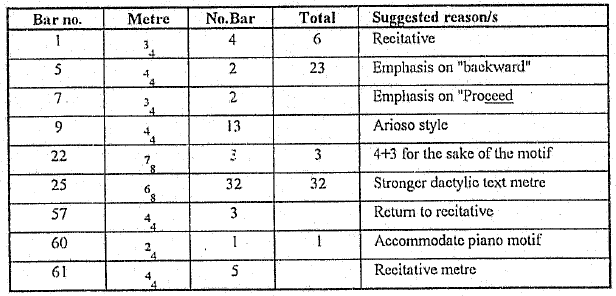
The 16 bars of recitative (7+9) account for 25% of the song and in these sections speech-rhythms are followed accurately. The middle section (b. 9-56) remains in arioso style, again a close link with natural speech rhythm.
Rhythmic motifs
The most prominent motif consisting of two semi-quavers and a crotchet (motif 1) has its origins early in the song, bar 2 (voice) and occurs 10 times in the voice (b. 2-6, 10, 12, 13, 21, 39, 52) and 11 times in the piano part (b. 22(2), 23(2), 24(2), 36, 41, 42). Motif 1, used in the piano with legato-note slur, occurs mostly from bars 22-25 and has already been discussed. Another prominent motif consisting of three quavers (motif 2) establishes itself between bars 26 -56. Motif 2, (b. 26(2), 27(4), 28(2), 29(2), 30, 31, 35, 46(2), 47, 51, 54, 55) also with melodic features, has the effect of binding the section into a tighter unit. The mostly descending use is related in meaning to the diminishing image of the beloved. The piano part has a number of independent rhythmic features. Pitches lasting a minim or longer occur 58 times. These cannot be considered as pedal notes but more a result of the recitative and arioso vocal styles. Then a localized motif consisting of a quaver-crotchet-quaver (motif 3) occurs 10 times in bars 18-21 which creates metric uncertainty, anticipating the text "But alas fro me..." (b. 19-20) and the metric change to 7/8 and 6/8. Finally, the eight-note semi-demi-quaver run which occurs in bars 1 and 60, needs to be mentioned. The initial one is a direct piano setting of the immediately preceding text, "the hair of my flesh stood up." (l. 1) and is the only introduction. the second, starting a fifth lower, introduces the final dooming words of the Spirit and musically rounds the song off very neatly.
Rhythmic activity vs. Rhythmic stagnation
the voice part is mostly rhythmically active while the piano part has stagnant periods. The introductory and final recitative sections have already been mentioned. Further rhythmic stagnation takes place in bars 32 -34 where in the adjacent text reference is made to the diminishing image of the beloved.
Rhythmically perceptive, erroneous and interesting settings
The following words have been interestingly or imaginatively dealt with rhythmically:

The following line has also been set very carefully

Notice how the punctuation has been followed carefully with a prolonged note or a rest.
Lengthening of voiced consonants
The following words containing voiced consonants have been rhythmically prolonged in order to make the words more singable:
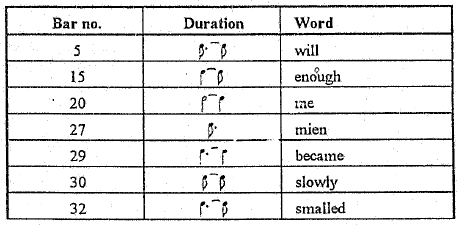
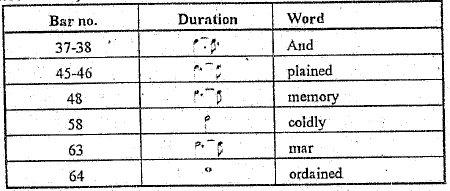
the tempo indication is Recit. Drammatico ![]() A number of deviations from this occur and these are listed below:
A number of deviations from this occur and these are listed below:

All the tempo variations are functional and closely linked to either meaning or structure.
3. Pitch
An interval analysis of the vocal line is represented in the following table:
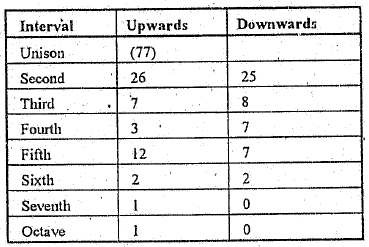
There are 77 repeated pitches (435 of the total number), 52 rising (295) and 49 falling (28%) intervals. The smaller intervals (thirds and smaller) account for 80% (or 143) of the total number while the larger intervals account for 20% (35 intervals). The high percentage of small intervals is largely due to the 77 repeated pitches which is in keeping with the recitative and arioso style of the vocal line.
Specific settings:
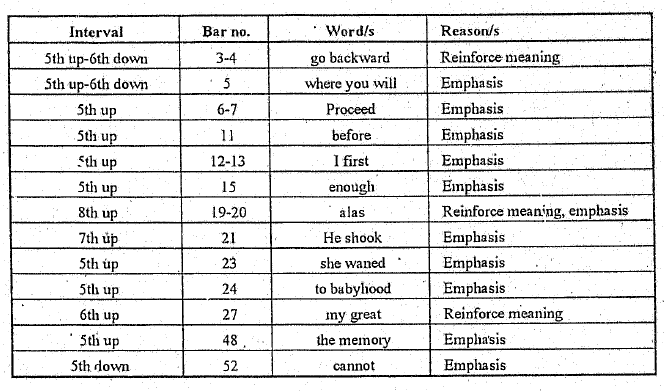
Melodic curve
A melodic curve of the vocal line is represented below. Certain words and phrases are indicated to show the relationship between the melodic curve and the meaning:
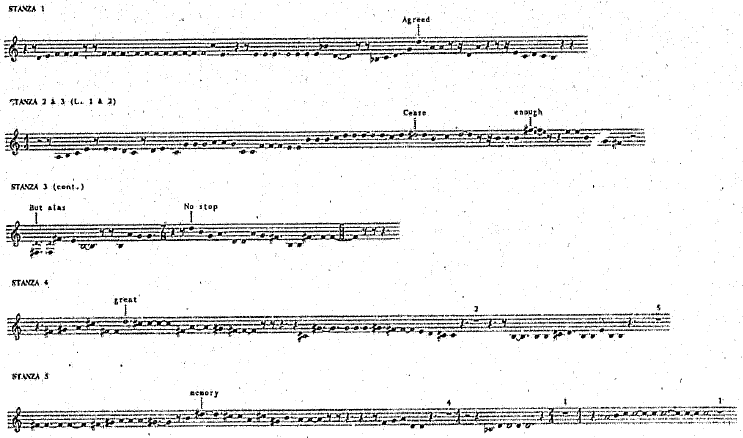
Climaxes
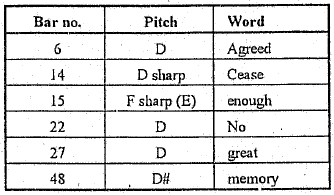
It is clear that the important passages in the text coincide with what the composer has set as climaxes.
Phrase lengths
The recitative sections have short vocal phrases, except for the final utterance of the Spirit, which is four bars long. In the arioso section there is a long phrase (b. 11-15) which leads up to the climax, "Thus far is good" (b. 15) and a fairly long phrase (b. 26-30) in which there is mention of the diminishing image of the beloved. In both these phrases a breath should be taken at the first tied note ![]() respectively).
respectively).
the technique of extended tonality (or modality) is operative in the song. The song starts clearly enough in d minor, but moves quickly through a minor (C major), e minor, and briefly around g minor to settle for some bars in f sharp minor. Hardly and of these keys are established with the traditional major, dominant chord (except in bars 13-14 (V in e) and 28 (![]() in f sharp)) and thus a modal impression is created, which is very suitable in supporting the atmosphere of the poem. Important "modulations" are listed below:
in f sharp)) and thus a modal impression is created, which is very suitable in supporting the atmosphere of the poem. Important "modulations" are listed below:

bars 62-63 contain a transition to f minor to add to the horror of the Spirit's final words.
Chromaticism
There are many chromatic notes which have a colour function mostly. The heightened dissonance that they create is instrumental in establishing the mood of the song (b. 3(D flat), 5(G sharp), 14(C sharp), 15(C sharp and A sharp), 17(A sharp), 18(G sharp), 18-9(C sharp), 21(B flat), 23(B flat), 26(F natural), 37(G natural), 45(E and C natural), 49(C and F natural), 53(E flat), 59(B flat and E flat), 62-3(A flat and E flat, D flat and A flat)).
HARMONY AND COUNTERPOINT
A number of harmonic accents are use in addition to the dynamic accents. These all contain heightened dissonance and are listed below:

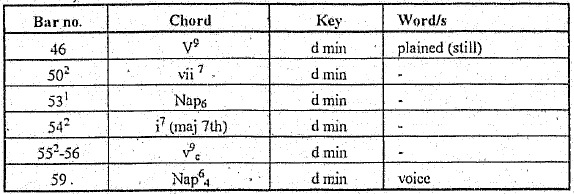
the three important moments here are the chords with "sorrow", "plained" and "voice". These concepts are aptly supported by the dissonance of their harmonic surroundings. The occasions where the piano is by itself, generally reiterate the preceding text.
Non-harmonic tones
the simultaneous use of two different non-harmonic tones on bar ![]() (piano: A - accented passing note and E - sounded suspension), suggests a momentary pang of pain, recollecting the beloved as a young woman. Apart from the rhythmic significance of motif 1, it is at the same time used in a succession of suspensions (b. 22-25), emphasizing its importance and contributing to the meaning of the gradually diminishing image of the beloved. Finally, the two contrary-motion passing notes in bar 26, the descending chromatic and the ascending diatonic need to be mentioned: they occur with the text, "Still less in mien" and therefore suggest something of the shrinking of the image.
(piano: A - accented passing note and E - sounded suspension), suggests a momentary pang of pain, recollecting the beloved as a young woman. Apart from the rhythmic significance of motif 1, it is at the same time used in a succession of suspensions (b. 22-25), emphasizing its importance and contributing to the meaning of the gradually diminishing image of the beloved. Finally, the two contrary-motion passing notes in bar 26, the descending chromatic and the ascending diatonic need to be mentioned: they occur with the text, "Still less in mien" and therefore suggest something of the shrinking of the image.
Harmonic devices
Though there are many longer notes, as mentioned earlier, there are relatively few pedal points. Only the chords extending from bars 40-42 and 42-43 can be considered as inverted pedal notes. These pedal chords help to create suspense after the final disappearance of the image, much as the bar of rest does (b. 44).
Counterpoint

Loudness variation is given in the following summary:
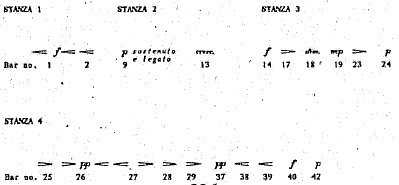

FREQUENCY
There are 43 indications in 65 bars 9an average 66% of the bars containing indications). There are also a number of separate indications for the voice (b. 1, 9, 13, 14, 38-39, 61, 62) but these coincide exactly with the piano indications. This means that where no separate indications are provided for the voice, the piano indications should be followed.
RANGE
the highest level, fff is found in the final bar (b. 65) and is in the company of a low six-part a minor chord. The dramatic final words of the Spirit are almost maliciously forced into the listener's mind. The most quiet level, pp occurs a number of times where the composer is more sympathetic towards the persona's tender feelings of loss (b. 26, 37, 51).
VARIETY
The indications used are:
![]()
DYNAMIC ACCENTS
Dynamic accents have been listed and discussed before under piano articulation.
The density varies loosely between two and seven parts including both piano and voice. The thickness of the piano part is represented in the following table:

The first item in the table refers to the silent bar (b. 44), which is prolonged by a pause and represents a dramatic "holding of breath" due to the shock of the preceding realization: the destruction of the persona's memory of the beloved. The only eight-part chord occurs in bar 16, with the climactic shout, "enough". The power of the persona's emotion is supported by the textural thickening. The dominant textures are the four- five- and six-part textures which account for 78% of the bars. This rather thick chordal texture is in keeping with the generally dark and gloomy atmosphere of the song.
The structure of the song can be represented in the following table:

The song follows the through-composed method but the reference to the opening recitative is too obvious to ignore and thus there are also vague ternary elements. This is supported by the suggested tonality structure, even if a very vague one itself.
7. Mood and atmosphere
the mood of the song is macabre on the one hand and pitiful on the other. References to the Spirit's presence and words fall in the first category and references to the persona's state of mind and emotion in the second. The harmonic instability, dissonant accents, favoured lower register of the piano, recitative and arioso vocal style are the main contributors to the mood.
General comment on style
Dissonance within an extended tonality (or modality) characterizes the piano part: a forbidding atmosphere is set and sustained. The recitative and arioso vocal style is apparent from the 43% repeated pitches and 80% use of smaller intervals. This indicates a sympathetic treatment of the voice without being uninventive. The piano provides recitativo accompanato and stomentato accompaniment styles which are appropriately varied with the recitative and arioso singing style.
Unpublished Analysis Excerpts
The following is an analysis of The Clock of the Years by Curtis Alan Scheib. Dr. Scheib extended permission to post this excerpt from his dissertation on February 17th, 2012. His dissertation dated 1999, is entitled:
Gerald Finzi's Songs For Baritone On Texts By Thomas Hardy: An Historical And Literary Analysis And Its Effect On Their Interpretation
This excerpt begins on page forty-seven and concludes on page forty-nine.
The Clock of the Years |
||
|---|---|---|
'A spirit passed before my face; the hair of my flesh stood up.' |
||
| And the Spirit said, | ||
| 'I can make the clock of the years go backward, | ||
| But am loth to stop it where you will.' | ||
| And I cried, 'Agreed | ||
| To that. Proceed: | ||
| It's better than dead!' | ||
| He answered, 'Peace;' | ||
| And called her up - as last before me; | ||
| Then younger, younger she freshed, to the year | ||
| I first had known | ||
| Her woman-grown, | ||
| And I cried, 'Cease! - | ||
| 'Thus far is good - | ||
| It is enough - let her stay thus always!' | ||
| But alas for me - He shook his head: | ||
| No stop was there; | ||
| And she waned child-fair, | ||
| And to babyhood. | ||
| Still less in mien | ||
| To my great sorrow became she slowly, | ||
| And smalled till she was nought at all | ||
| In his checkless griff; | ||
| And it was as if | ||
| She had never been. | ||
| 'Better,' I plained, | ||
| 'She were dead as before! The memory of her | ||
| Had lived in me; but it cannot now!' | ||
| And coldly his voice: | ||
| 'It was your choice | ||
| To mar the ordained.' | ||
(Hardy, 528-9) |
||
Here again, Hardy is dealing with memory. This is not the nostalgic memory of an unrequited love however, but a cautionary tale about the consequences of tampering with memory. The cruelness of time, a theme in much of Hardy's poetry, is present here as well. Finzi's setting begins with the marking Recit: Drammatico and proceeds in an almost cantata-like fashion with alternating recitative and arioso sections. The dramatic nature of the song, as seen in example 13, is further enhanced by the first line of text, which is to be spoken.

The piano here plays an important role in the drama as well, the motive that accompanies "Agreed to that" being repeated several times instrumentally (example 14).
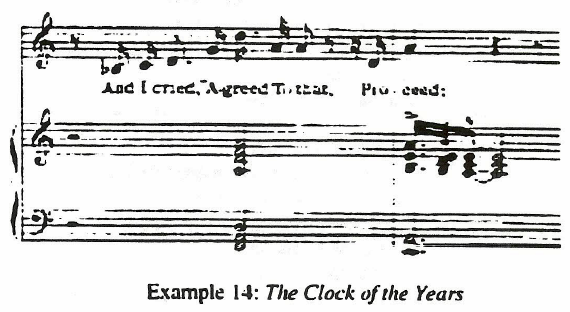
The dialogue is carried on in this manner throughout the song, Finzi's word setting filled with a dramatic force that is joined and echoed in the piano. Beyond the cantata-like structure, there is a harmonic element at work here that binds the structure. Finzi uses a progression of keys for each section that moves backwards through the circle of fifths. From the beginning D minor, the song moves through A, E, B, F# and C# minor as the clock is rewound. There is a brief hushed passage in B minor when the poet realizes what he has done, an abrupt return to D minor and a final proclamation from the spirit in A minor. The total effect of all these elements is of heightened drama, reminiscent of Schubert and Brahms. (Banfield, 211)
The preceding was an analysis of The Clock of the Years by Curtis Alan Scheib. Dr. Scheib extended permission to post this excerpt from his dissertation on February 17th, 2012. His dissertation dated 1999, is entitled:
Gerald Finzi's Songs For Baritone On Texts By Thomas Hardy: An Historical And Literary Analysis And Its Effect On Their Interpretation
The excerpt began on page forty-seven and concluded on page forty-nine.

